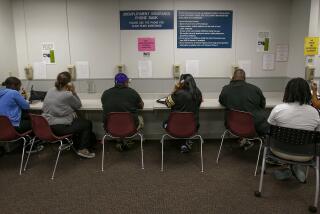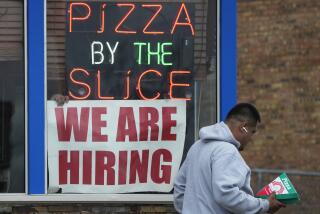Fewer Americans filed for jobless benefits last week, but applications remain slightly elevated

The number of Americans filing for jobless benefits fell last week but remain at slightly elevated though not troubling levels.
Jobless claims for the week of Aug. 3 fell by 17,000 to 233,000 last week, the Labor Department reported Thursday.
That’s fewer than the 240,000 analysts surveyed by FactSet were expecting.
Weekly unemployment claims are widely considered representative of layoffs, and though they have trended higher recently, they remain at historically healthy levels.
Continuing claims, which represent the total number of Americans collecting unemployment benefits, rose by 6,000 for the week of July 27 to 1.88 million. That’s the most in more than three years, but also not particularly worrisome, analysts say.
Thursday’s report was the first snapshot of the U.S. labor market since last week’s deeply disappointing jobs data for July sent financial markets spiraling on fears that the economy might be edging toward a recession. Some analysts had suggested that the Federal Reserve might respond by accelerating its timetable for cutting interest rates or cut rates more deeply than previously envisioned.
In recent days, though, most economists have cautioned that the July jobs report did not portend a recession. They noted that by most measures, the economy, while slowing, remains resilient.
It’s nail-biting time on Wall Street. Stocks had been dropping at worrisome rates for several days, but on Monday things went from concerning to panicky.
Last week, many economists and traders had grown concerned after the government reported a much lower-than-expected job gain for July and the unemployment rate reached 4.3%, its highest point since October 2021, when the economy was still recovering from the pandemic recession. The fact that continuing claims for unemployment aid ticked up only slightly last week was reassuring.
“It’s not in free-fall,” said Nick Bunker, economic research director for North America at the Indeed Hiring Lab. “It’s just continuing the moderation that we’ve been seeing.”
Bunker was hesitant to give a specific number of jobless claims that would worry him. However, a sustained increase — combined with other bad data — would be cause for concern, he said.
Stocks on Wall Street opened higher as investors welcomed the better-than-expected layoffs number.
Most Fed watchers still expect the central bank’s policymakers to begin cutting their benchmark rate by a modest quarter-point when they meet in mid-September.
The Fed raised its benchmark borrowing rate 11 times in 2022 and 2023 to fight the worst streak of inflation in four decades, which coincided with the economy’s powerful rebound from the pandemic recession of 2020. The Fed’s intention was to cool a hot labor market and slow wage growth.
Inflation has plummeted from its highs to near the Fed’s 2% target, and now the central bank appears more focused on the need to support the economy with gradually lower borrowing rates.
Filings for unemployment benefits have been consistently higher beginning in May. Last week’s 250,000 claims were the highest in a year. Since May, applications have averaged about 232,000 per week. In the three months before that, weekly claims averaged just 212,000.
On Friday, the government reported that U.S. employers added just 114,000 jobs in July, a sharp decline from June and well below analyst forecasts of 175,000. The unemployment rate rose for the fourth straight month, to 4.3%. That report struck fear in markets around the world because a sturdy U.S. economy has been a key driver of global economic growth.
Other recent economic data have been telling a similar story of a slowing U.S. economy. Manufacturing activity is still shrinking, and its contraction is accelerating. Manufacturing has been one of the areas of the economy hurt most by high rates.
High interest rates have also taken their toll on the housing market, which has seen sales of existing homes decline for four straight months. The slump dates back to 2022, with existing home sales hitting a nearly 30-year low last year.
Retail sales were flat in June from May and many retailers say that Americans are being more judicious about their spending.
None of the data necessarily portends an imminent recession, experts say, but combined it is building a case for the Fed to cut its benchmark rate in September.
Thursday’s report also said that the four-week average of claims, which evens out some of the weekly volatility, rose by 2,500 to 240,750.
There have been job cuts across a diversity of sectors this year, including the agricultural manufacturer Deere, media outlets like CNN and elsewhere.
Ott writes for the Associated Press.
More to Read
Inside the business of entertainment
The Wide Shot brings you news, analysis and insights on everything from streaming wars to production — and what it all means for the future.
You may occasionally receive promotional content from the Los Angeles Times.







